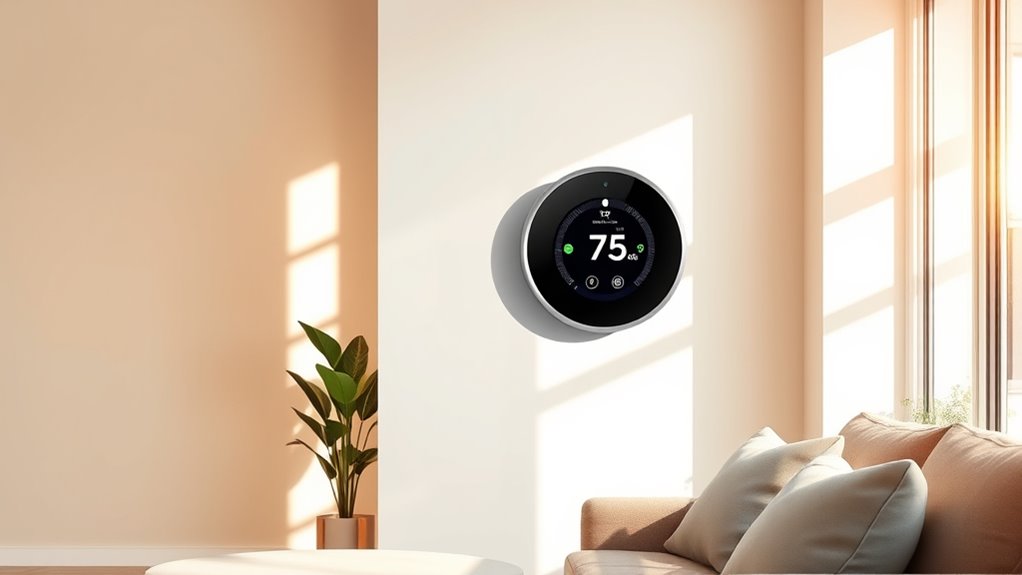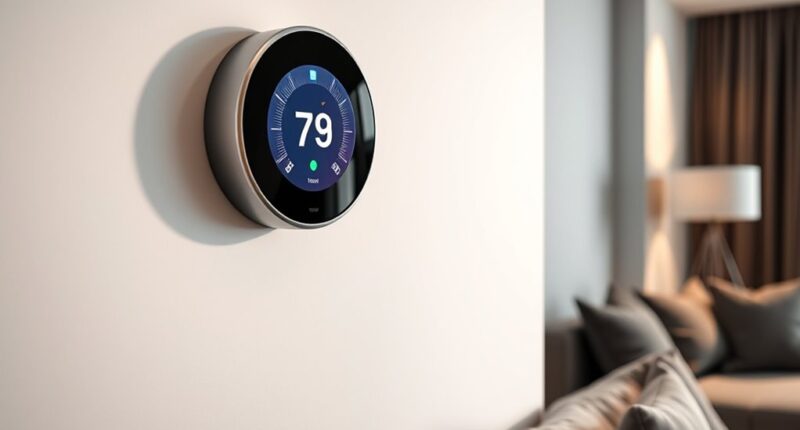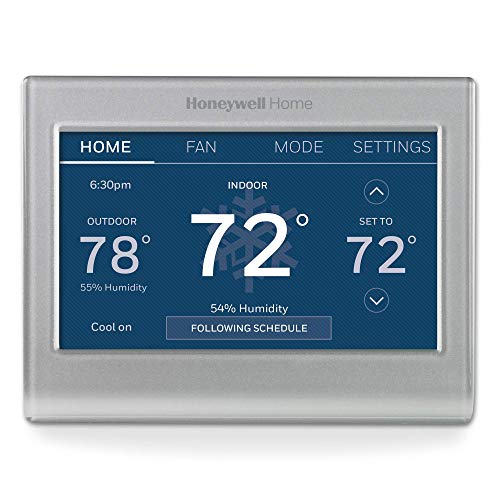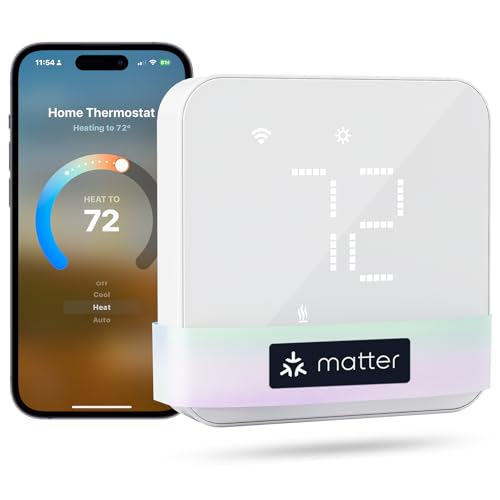If you’re looking for the best smart thermostats of 2025 to save energy and boost comfort, I recommend checking out options like Ecobee’s models, which offer up to 26% savings with features like occupancy sensing and easy installation. The Google Nest also provides adaptive scheduling and sleek designs, while Sensi thermostats are user-friendly and compatible with many systems. Keep exploring, and you’ll find the perfect fit that balances efficiency and convenience for your home.
Key Takeaways
- Top models like Ecobee, Nest, and Sensi offer significant energy savings up to 26% through adaptive scheduling and occupancy detection.
- Compatibility with major HVAC systems and smart home platforms ensures seamless integration and easy installation.
- User-friendly interfaces with touchscreen controls and remote access enhance comfort and convenience.
- Advanced features such as humidity control, system monitoring, and demand response optimize energy use and system health.
- Modern designs and certifications like ENERGY STAR combine aesthetics with sustainability benefits.
ecobee Smart Thermostat Essential – Wi-Fi Programmable Thermostat
If you’re looking for an affordable and easy-to-install smart thermostat that can considerably cut your energy bills, the ecobee Smart Thermostat Essential is an excellent choice. It can save you up to 23% annually on heating and cooling costs by automatically adjusting to your schedule, saving energy when you’re away, and increasing comfort when you’re home. You can track your energy usage remotely via the ecobee app, and software updates keep it running efficiently. Compatibility is broad, supporting most HVAC systems and major smart home ecosystems like Apple HomeKit, Google Assistant, and Alexa. Its user-friendly touchscreen and DIY setup make installation straightforward.
Best For: homeowners seeking an affordable, easy-to-install smart thermostat that offers significant energy savings and compatibility with major smart home ecosystems.
Pros:
- Saves up to 23% annually on heating and cooling costs, reducing energy bills.
- Easy DIY installation with a user-friendly touchscreen and remote control via the ecobee app.
- Broad compatibility with most HVAC systems and smart home platforms like Apple HomeKit, Google Assistant, and Alexa.
Cons:
- May require optional Power Extender Kit (PEK) for homes without a C-wire, which incurs additional cost.
- Limited advanced customization features compared to more premium models.
- Availability of accessories like the trim kit and PEK is sold separately, potentially increasing overall setup costs.
Amazon Smart Thermostat
The Amazon Smart Thermostat is an ideal choice for homeowners seeking an affordable, easy-to-install device that seamlessly integrates with Alexa and Ring apps. It’s compatible with most 24V HVAC systems, including conventional force air, heat pumps, and radiant boilers, but not with 110-240V systems like electric baseboard heaters. The setup is straightforward using the Alexa app, often requiring a C-wire or power adapter kit. Made with Honeywell technology, it’s ENERGY STAR and ECOLOGO Gold certified, ensuring energy savings. The sleek design and app control make managing comfort simple, while AI-driven features optimize temperature based on your routines.
Best For: homeowners seeking an affordable, easy-to-install smart thermostat compatible with Alexa and Ring, with energy-saving features and straightforward app control.
Pros:
- Easy to install with guided setup via the Alexa app.
- Compatible with most 24V HVAC systems, supporting various heating and cooling setups.
- Certified ENERGY STAR and ECOLOGO Gold, promoting energy efficiency and sustainability.
Cons:
- Not compatible with 110-240V systems like electric baseboard heaters.
- Possible connectivity issues or initial setup challenges on older devices.
- Limited compatibility with certain HVAC wiring configurations and system types, requiring careful pre-installation research.
ecobee Smart Thermostat Enhanced Programmable Wi-Fi Thermostat
The ecobee Smart Thermostat Enhanced stands out as an ideal choice for homeowners seeking precise, energy-saving control over their HVAC systems. It adapts to your lifestyle, adjusting temperature based on occupancy, and suggests schedule changes to maximize savings—up to 26% annually. Compatible with 90% of systems and supporting major voice assistants like Alexa, Siri, and Google, it’s easy to install, even without a C-wire. Its sleek design features a bright LCD, and the device responds instantly to voice commands. With features like humidity control, occupancy sensing, and remote access, it offers a seamless, smart home experience that boosts comfort and reduces energy costs.
Best For: homeowners seeking a sleek, energy-efficient smart thermostat that seamlessly integrates with various voice assistants and HVAC systems for precise climate control and cost savings.
Pros:
- Compatible with 90% of HVAC systems, including various types like gas, electric, and heat pumps
- Easy to install with comprehensive guidance and a Power Extender Kit option for homes without a C-wire
- Offers automatic energy savings, occupancy sensing, humidity control, and remote access for enhanced comfort and efficiency
Cons:
- Some users may experience compatibility issues with certain HVAC setups
- Fingerprint visibility on the glossy screen may require regular cleaning
- Lacks certain advanced features like geofencing or fan delay options in some models
Sensi Smart Thermostat
Looking for a smart thermostat that’s easy to install and offers reliable energy savings? The Sensi Smart Thermostat (Model ST55) fits the bill perfectly. It’s Wi-Fi enabled, Energy Star certified, and compatible with Alexa, making it simple to control from anywhere. Designed for quick DIY setup, it fits standard thermostat spaces and often doesn’t need a C-wire. With features like flexible scheduling, remote access, and detailed usage reports, it helps cut HVAC energy use by around 23%. Plus, it prioritizes your privacy and provides maintenance alerts, ensuring your system runs efficiently while saving energy and lowering bills.
Best For: homeowners seeking an easy-to-install, energy-efficient smart thermostat that offers remote control and compatibility with Alexa.
Pros:
- Simple DIY installation with step-by-step app guidance and no need for a C-wire in most cases
- Saves approximately 23% on HVAC energy consumption through flexible scheduling and remote access
- Maintains user privacy by not selling personal data to third parties
Cons:
- May not be compatible with all HVAC systems, especially those requiring a C-wire
- Limited advanced customization options compared to more complex smart thermostats
- Some users might prefer a touchscreen interface over physical buttons for easier operation
Google Nest Thermostat, Programmable Wi-Fi Smart Thermostat
If you’re seeking a smart thermostat that combines energy efficiency with user-friendly remote control, the Google Nest Thermostat is an excellent choice. It’s ENERGY STAR certified and works without a C wire in most homes, making installation simple. With Wi-Fi and Bluetooth connectivity, you can control your thermostat from anywhere using the Google Home app on your phone or tablet. It automatically creates energy-saving schedules, turning down when you leave home. Plus, it monitors your HVAC system, alerting you to issues and reminding you about maintenance. Overall, it’s a sleek, reliable option for boosting comfort while reducing energy bills.
Best For: those seeking an easy-to-install, energy-efficient smart thermostat with remote control capabilities that works in most homes without the need for a C wire.
Pros:
- ENERGY STAR certified for energy savings and efficiency
- Wireless connectivity via Wi-Fi and Bluetooth for remote control from anywhere
- Automatically creates and adjusts energy-saving schedules based on routines
Cons:
- Does not include a lock feature for restricting access
- Some heating-only or cooling-only systems may require additional wiring or accessories
- Compatibility with certain HVAC systems should be verified using the online Nest Compatibility Checker
Sensi Lite Smart Thermostat
For homeowners seeking a straightforward, budget-friendly smart thermostat, the Sensi Lite by Emerson stands out as an excellent choice. It’s easy to install yourself, thanks to a built-in level and step-by-step instructions, and it works with most HVAC systems without needing a C-wire. Wi-Fi connectivity allows remote control via a user-friendly app, compatible with Alexa and Google Assistant. Certified by Energy Star, it helps save around 23% on energy bills through programmable scheduling and environmental monitoring. While some users report wiring and connectivity issues, overall, it offers reliable features, a sleek LCD display, and a 3-year warranty, making it a solid choice for cost-conscious homeowners.
Best For: homeowners seeking an affordable, easy-to-install smart thermostat with remote control capabilities and compatibility with popular voice assistants.
Pros:
- Simple DIY installation with step-by-step instructions and built-in level
- Wi-Fi connectivity allows remote management via a user-friendly app
- Energy Star certified, helping reduce HVAC energy costs by approximately 23%
Cons:
- Some users experience wiring compatibility and connectivity issues
- Limited advanced features; lacks schedule copying across multiple units
- Customer support experiences can involve long wait times and occasional faulty units
ecobee Smart Thermostat Premium with Smart Sensor and Air Quality Monitor
The ecobee Smart Thermostat Premium with Smart Sensor and Air Quality Monitor is ideal for homeowners seeking both energy efficiency and advanced environmental monitoring. It can save up to 26% annually on heating and cooling costs, earning ENERGY STAR certification. The included SmartSensor targets key rooms, reducing hot and cold spots for better comfort. Its built-in air quality monitor alerts you to poor conditions and reminds you to change filters. It also detects temperature drops and monitors doors and windows, automatically pausing the HVAC to save energy. With voice control, smart home integration, and a premium design, this thermostat offers a sophisticated, eco-friendly way to manage your home.
Best For: homeowners seeking to reduce energy costs while enjoying advanced environmental monitoring and smart home integration.
Pros:
- Up to 26% annual savings on heating and cooling costs, ENERGY STAR certified
- Includes SmartSensor and built-in air quality monitor for enhanced comfort and health
- Compatible with most HVAC systems and supports voice control with Siri, Alexa, and Google Assistant
Cons:
- Requires ecobee Smart Security subscription for full security features
- Apple home hub needed for Siri integration, which may add extra setup complexity
- Premium design and features may come at a higher price point compared to standard thermostats
RTH9585WF1004 Wi-Fi Smart Color Thermostat
Looking to enhance your home’s energy efficiency with a sleek, customizable thermostat? The RTH9585WF1004 Wi-Fi Smart Color Thermostat is a great choice. It’s 7-day programmable, has a bright, easy-to-use touchscreen, and is Energy Star certified. You can personalize its color to match your decor and control it with Alexa for voice commands. It offers flexible scheduling and tracks your heating and cooling habits, providing helpful energy-saving tips. Compatible with most forced air systems, it’s ideal for creating a comfortable, energy-efficient environment. Just make sure your system has a C-wire, and check for rebates or utility programs to maximize savings.
Best For: homeowners seeking a customizable, energy-efficient smart thermostat compatible with Alexa and various heating systems.
Pros:
- Personalized color options to match home decor
- Easy-to-read touchscreen with simple operation
- Energy-saving features including usage reports and tips
Cons:
- Requires a C-wire for installation in many systems
- Does not support electric baseboard heating (120-240V)
- Compatibility must be verified with existing heating and cooling systems
Google Nest Learning Thermostat and Temperature Sensor (4th & 2nd gen)
If you’re seeking a sleek, highly intelligent thermostat that learns your routines and helps cut energy costs, the Google Nest Learning Thermostat (4th and 2nd gen) is an excellent choice. It features a stylish design with a larger touchscreen, dynamic Farsight, and automatic brightness adjustment, blending seamlessly into modern homes. The thermostat supports voice control via Google Assistant, Alexa, or Siri, and connects remotely through the Google Home app. It can learn your preferences, set schedules, and manage hot or cold spots with optional Nest Temperature Sensors. Despite some installation and compatibility quirks, many users appreciate its adaptive features, energy savings, and intuitive interface.
Best For: homeowners seeking a stylish, intelligent thermostat that adapts to routines and offers energy savings with easy remote control and voice assistant compatibility.
Pros:
- Learns user preferences and routines for automatic adjustments
- Supports remote control via app and voice commands with Google Assistant, Alexa, and Siri
- Features a modern, sleek design with a larger touchscreen and dynamic Farsight for visibility
Cons:
- Installation can be challenging, especially with wiring compatibility issues
- Mounting hardware differs from previous models, potentially causing compatibility problems
- Support for troubleshooting is limited, which may complicate setup and repairs
Like-New Amazon Smart Thermostat
For homeowners seeking a cost-effective way to upgrade their heating and cooling system, the Like-New Amazon Smart Thermostat offers a reliable, ENERGY STAR-certified option that combines easy DIY installation with smart automation. This refurbished device is tested and certified to look and work like new, and it includes the same limited warranty as a brand-new product. It requires a C-wire and can help save about $50 annually on energy bills. Plus, Amazon provides rebate information from local providers. You can control it remotely via the Alexa app, and it integrates with Echo devices for automated comfort and voice control. Customer support is readily available to guide you through setup.
Best For: homeowners seeking an affordable, easy-to-install smart thermostat that enhances energy efficiency and offers remote control capabilities.
Pros:
- ENERGY STAR certified, helping to reduce energy costs by approximately $50 annually
- DIY installation with guided setup via the Alexa app, no professional help needed
- Integration with Alexa and Echo devices for voice control and automation
Cons:
- Requires a C-wire for installation, which may not be present in all homes
- Refurbished device may come in generic packaging, though it is tested and certified to look and work like new
- Limited warranty compared to brand-new devices, which might be a concern for some users
Sensi Touch 2 Smart Thermostat with Touchscreen
The Sensi Touch 2 Smart Thermostat with Touchscreen stands out as an excellent choice for homeowners seeking an easy-to-install, energy-efficient device that combines sleek design with advanced smart features. Its 5.6-inch LCD touchscreen offers intuitive control, while Wi-Fi connectivity enables remote access through a user-friendly app. Compatible with most HVAC systems and popular smart home platforms like Alexa and Google Assistant, it helps save around 23% on energy costs. Installation is straightforward with detailed guidance, though a C-wire is necessary. Its features include flexible scheduling, geofencing, room sensors, and performance alerts, making it a smart, reliable upgrade for comfort and efficiency.
Best For: homeowners seeking an easy-to-install, energy-efficient smart thermostat with advanced features and sleek design compatible with various smart home platforms.
Pros:
- Intuitive 5.6-inch LCD touchscreen for simple control and navigation
- Energy savings of approximately 23% through flexible scheduling and smart features
- Compatibility with major smart home systems like Alexa, Google Assistant, and Samsung SmartThings
Cons:
- Initial Wi-Fi setup can be challenging, with occasional connectivity issues during installation
- Requires a common C-wire for installation, which may not be available in all homes
- Some users report minor delays or glitches in app connectivity or updates
Honeywell Home Smart Thermostat with WiFi Connectivity
The Honeywell Home Smart Thermostat with WiFi Connectivity stands out as an ideal choice for homeowners seeking seamless integration with their existing smart home systems. It’s compatible with Amazon Alexa, Google Assistant, and Apple HomeKit, making control effortless. Designed for conventional and heat pump systems, it requires a C-wire or a power adapter. You can control it remotely via the First Alert app and enjoy features like humidity monitoring, filter reminders, and auto-away. Certified by Energy Star, it promotes energy savings through smart scheduling and demand response. With a 2-year warranty, it offers reliable performance and customization options to boost comfort while reducing energy bills.
Best For: homeowners seeking a versatile, WiFi-enabled smart thermostat compatible with multiple smart home platforms and energy-saving features.
Pros:
- Compatible with Amazon Alexa, Google Assistant, and Apple HomeKit for seamless voice control
- Supports demand response and Energy Star certification for energy savings and rebate participation
- Customizable display, humidity monitoring, and auto-away features for enhanced comfort and convenience
Cons:
- Requires a C-wire or power adapter for installation, which may not be available in all systems
- Non-programmable options are limited; some users may prefer more advanced scheduling features
- The need for app control may be less convenient for those preferring manual thermostat adjustments
Emerson Sensi Touch Wi-Fi Smart Thermostat
Looking to upgrade your home with a sleek, user-friendly smart thermostat? The Emerson Sensi Touch Wi-Fi Smart Thermostat might be just what you need. Its modern design features a large, colorful touchscreen that’s easy to read and navigate. Installation is straightforward, with step-by-step app instructions and compatibility with most HVAC systems—just make sure you have a common C-wire. Certified by ENERGY STAR, it can cut your energy bills by about 23% thanks to flexible scheduling and remote control. Plus, you can manage everything from your smartphone or tablet, monitor performance, and get maintenance alerts—all while keeping your privacy intact.
Best For: homeowners seeking an easy-to-install, energy-efficient smart thermostat with modern design and remote control capabilities.
Pros:
- User-friendly large color touchscreen display for easy navigation
- Compatible with most HVAC systems, including DIY installation with step-by-step app guidance
- Helps reduce energy costs by approximately 23% through flexible scheduling and remote access
Cons:
- Requires a common C-wire for proper installation in most systems
- Limited color options (black, white, silver) may not match all décors
- Does not include advanced smart home integrations beyond basic Wi-Fi connectivity
meross Smart Thermostat for Home, WiFi Thermostat
For homeowners seeking a reliable, easy-to-install smart thermostat that integrates seamlessly with popular smart home platforms, the meross Smart Thermostat (Model MTS300) stands out. It supports 95% of HVAC systems, including heat pumps and conventional setups, but requires a C-wire or adapter. Compatible with Apple Home, Alexa, Google, and SmartThings via Matter, it offers 24/7 scheduling and remote control through a mobile app. Calibration guarantees accurate temperature readings, and automation options allow for energy savings with scenes based on time or location. Its straightforward installation and broad compatibility make it a solid choice for those wanting a flexible, user-friendly smart thermostat.
Best For: homeowners looking for a reliable, easy-to-install smart thermostat that integrates with major smart home platforms and offers customizable scheduling and energy-saving automation.
Pros:
- Supports 95% of HVAC systems, including heat pumps and conventional setups
- Seamless integration with Apple Home, Alexa, Google Assistant, and SmartThings via Matter protocol
- Offers 24/7 scheduling, remote control via mobile app, and calibration for accurate readings
Cons:
- Requires a C-wire or adapter for installation, which may complicate setup in some homes
- Limited to 2.4GHz Wi-Fi networks, potentially requiring router adjustments
- Lacks occupancy detection sensors, relying on automation platforms for energy-saving modes
RTH9600WF Smart Wi-Fi Color Thermostat
If you want a stylish, customizable thermostat that seamlessly integrates with your smart home and helps reduce energy bills, the Honeywell RTH9600WF Smart Wi-Fi Color Thermostat is an excellent choice. Its high-definition color touchscreen display allows you to match your decor and change colors easily. It supports flexible scheduling and automatically switches between heat and cool modes using Honeywell’s Smart Response technology, learning your home’s cycle times for maximum comfort. Compatible with various HVAC systems, it offers remote control via app and voice commands through Alexa, Google Assistant, and others. With ENERGY STAR certification and a simple setup, it’s a reliable upgrade for smarter, more efficient home climate control.
Best For: homeowners seeking a stylish, customizable, and smart thermostat that can optimize energy savings and seamlessly integrate with voice assistants.
Pros:
- High-definition color touchscreen with customizable display options matching decor
- Supports remote management and voice control via app and smart home platforms
- Learns home cycle times with Honeywell’s Smart Response technology for optimal comfort
Cons:
- Requires C-wire for power; compatibility check needed for some HVAC systems
- Some users experience initial Wi-Fi setup challenges or wiring compatibility issues
- App updates and background display aesthetics could be improved based on user feedback
Factors to Consider When Choosing Smart Thermostats

When selecting a smart thermostat, I consider how well it works with my HVAC system and how easy it is to install. I also look at whether it supports my existing smart home devices and offers energy-saving features. Plus, a user-friendly interface makes daily adjustments much simpler.
Compatibility With HVAC Systems
Choosing a smart thermostat that works smoothly with your HVAC system starts with verifying compatibility. First, check if it supports your system type—gas, electric, oil, heat pump, or boiler—to ensure proper operation. You’ll also want to see if your system needs a common wire (C-wire); some thermostats require it, while others can run without one using power extender kits. Confirm that the thermostat matches your system’s voltage and wiring configuration to avoid installation issues or potential damage. Additionally, if you have multi-stage heating or cooling, or zone control systems, ensure the thermostat supports these features to maximize energy savings and advanced scheduling. Finally, consult manufacturer compatibility lists or online checkers to make sure your existing HVAC components will work seamlessly with your new smart thermostat.
Ease of Installation Process
The ease of installing a smart thermostat can make a big difference in how smoothly your upgrade goes. A straightforward process, with clear instructions via apps or printed guides, helps reduce setup time and frustration. Models that require minimal wiring, especially those that don’t need a C-wire, are typically easier for DIYers. Compatibility with your existing HVAC system is key; using online checkers can prevent surprises during installation. Devices with built-in levels, labeled wiring terminals, and simple mounting hardware make the process faster and more accurate. Many users find that doing a bit of pre-installation research and watching setup tutorials considerably improves their experience. Overall, choosing a thermostat designed with ease of installation in mind can save you time and hassle.
Smart Home Ecosystem Support
Integrating a smart thermostat into your existing smart home ecosystem is essential for smooth operation and convenience. Make sure it’s compatible with your current platforms like Alexa, Google Assistant, Apple HomeKit, or Samsung SmartThings, so everything works seamlessly. Check if the thermostat supports the Matter protocol, which ensures broader device interoperability across multiple systems. Confirm the device is compatible with your HVAC system and wiring to prevent installation issues and maximize functionality. Also, see if you can control it via voice commands through your preferred smart assistant, adding to your convenience. Finally, look for remote management and automation routines, so your thermostat can respond to your smart home’s triggers for a truly integrated and efficient experience.
Energy Saving Features
Energy saving features are among the most important factors to contemplate when selecting a smart thermostat because they directly impact your monthly bills and environmental footprint. Many models can cut energy costs by automatically adjusting temperatures based on occupancy, schedules, or learned behaviors, often saving up to 23-26% annually. Geofencing is a handy feature that detects when you’re home or away, optimizing energy use without manual input. Programmable scheduling allows you to set specific temperature patterns for different times, preventing unnecessary HVAC operation when no one’s around. Additionally, real-time energy tracking and detailed reports help you spot inefficiencies and make smarter adjustments. Some thermostats even support utility rebates and demand response programs, giving you extra incentives to operate efficiently.
User Interface Design
Have you ever struggled to navigate a smart thermostat’s menu or felt frustrated by confusing controls? If so, you’re not alone. An intuitive user interface with a clear, easy-to-read display makes a huge difference in daily use and helps prevent setup errors. Responsive touchscreen controls that support multiple gestures or button presses ensure smooth navigation without frustration. The layout of menus and options should be logical, so adjusting settings takes as few steps as possible. Visual elements like icons, colors, and fonts need to be accessible, with sufficient contrast and adjustable font sizes for comfort and clarity. A well-designed interface also provides quick access to key functions like temperature adjustments, scheduling, and system modes, making the thermostat more user-friendly and efficient to operate.
Price and Rebate Opportunities
Considering the variety of prices and available incentives, evaluating rebate opportunities is essential when choosing a smart thermostat. Many models qualify for rebates from energy providers, which can substantially reduce the initial cost. Prices range from around $50 for basic units to over $250 for feature-rich options. ENERGY STAR certified thermostats often come with additional rebate benefits, making them more affordable overall. Seasonal sales and promotional discounts can also lower upfront expenses, helping you get more value for your money. Investing in a rebate-eligible smart thermostat not only saves money initially but can also lead to substantial energy bill savings over time. Typically, you can recoup your investment within a year, making rebates a smart way to maximize your purchase.
Frequently Asked Questions
How Do Smart Thermostats Impact Long-Term Energy Savings?
Smart thermostats considerably boost long-term energy savings by learning my schedule and adjusting temperature settings accordingly, which prevents unnecessary energy use. I’ve noticed lower utility bills and more consistent comfort at home. They also provide insights into my energy habits, helping me make smarter choices. Plus, remote control access means I can tweak settings on the go, ensuring ideal efficiency and savings over time.
Are Smart Thermostats Compatible With All HVAC Systems?
Not all smart thermostats are compatible with every HVAC system, so I always verify compatibility before buying. Most modern systems, like central air and heat pumps, work well, but some older or specialized setups might need additional wiring or adapters. I recommend consulting your HVAC manual or a professional to ensure the thermostat will integrate smoothly with your system. This way, you avoid surprises and get the most out of your smart thermostat.
What Are the Privacy Concerns Associated With Smart Thermostat Data?
Privacy concerns with smart thermostats can be surprising. I worry about how my data—when I’m home, my habits—gets collected and shared. These devices track detailed info, which could be vulnerable if hacked or sold. I always check privacy policies and make sure my network is secure. Staying cautious helps me enjoy smart comfort without risking my personal info. It’s a balance between convenience and privacy I refuse to compromise.
Can Smart Thermostats Be Controlled Remotely Without Internet Access?
Yes, some smart thermostats can be controlled remotely without internet access, but it depends on the model. Many rely on Wi-Fi for remote control, so without internet, you might lose that feature. However, certain thermostats use local networks or Bluetooth, allowing you to adjust settings directly through a connected device without needing an internet connection. Always check the specifications to confirm it meets your remote control needs.
How Do Smart Thermostats Integrate With Smart Home Ecosystems?
Smart thermostats seamlessly integrate with smart home ecosystems by connecting via Wi-Fi, Bluetooth, or Zigbee, enabling centralized control, automation, and voice commands. They sync effortlessly with devices like smart lights, security cameras, and voice assistants, creating a unified environment. This integration enhances convenience, saves energy, and boosts comfort, making your smart home more intuitive and responsive. I love how it all works together to simplify daily living.
Conclusion
Choosing the right smart thermostat is like finding a needle in a haystack, but with the right info, it’s a breeze. These options can help you save energy and boost comfort effortlessly. Remember, investing in the right device pays off in the long run. So, don’t put all your eggs in one basket—consider your needs carefully, and you’ll be well on your way to a smarter, more efficient home.

























